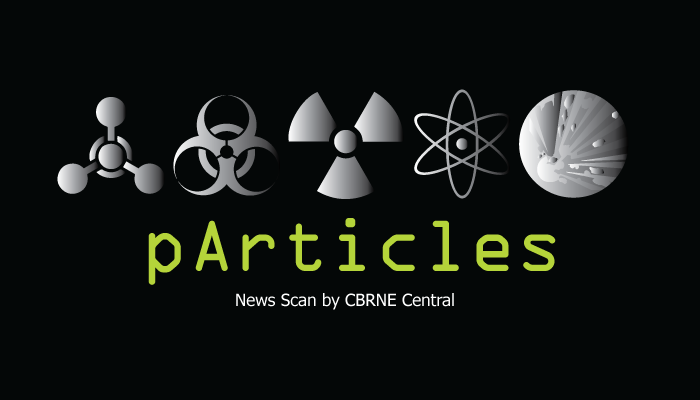Topics in this issue include first responder technology advances, infectious disease epidemic preparedness, and destruction of Libya’s chemical weapons materials.
In This Article
Mass Casualty Decontamination in a Chemical or Rad/Nuc Incident: Further Guiding Principles
This short report presents a response to an article written by Cibulsky et al. (2016). The paper by Cibulsky et al. presents a useful and timely overview of the evidence surrounding the technical and operational aspects of mass casualty decontamination. It identifies three priority targets for future research, the third of which is how casualties’ needs can be met in ways that best support compliance with and effectiveness of casualty decontamination. PLOS Currents Disasters >>
Canada Took Part in Secret Operation to Destroy Libyan Chemical Weapons
Canada took part in an international operation to secretly remove deadly chemicals – often turned into weapons – from Libya to keep them out of the hands of Islamic State fighters. The disarmament mission concluded last week when a Danish ship unloaded 500 metric tonnes of the chemicals at a German port for destruction at a commercial facility in the city of Munster over the next nine months. The maritime operation also involved the British, Spanish and Italian navies. The Globe and Mail >>
Report Warns of Medical Isotopes Shortage in USA
The current supply of molybdenum-99 (Mo-99) and technetium-99m (Tc-99m) is sufficient to meet domestic and global demand, but changes to the supply chain before year-end could lead to severe shortages and impact the delivery of medical care. World Nuclear News >>
U.S.-Led Coalition Destroys ISIS Chemical Weapons Factory Near Mosul
The U.S.-led coalition has destroyed a complex of buildings that housed an Islamic State militant group (ISIS) chemical weapons factory, the Pentagon said Tuesday. Air Force Lieutenant General Jeffrey Harrigian, who is in charge of the U.S. military’s air operations in the coalition, said that the elimination of the Iraq factory Monday had removed a “significant chemical threat” to civilians. Newsweek >>
First Responders Discuss Advances in Tech Since 9/11
When terrorists attacked New York and Washington, D.C., on Sept. 11, 2001, technology was quite different than it is today. There were no smartphones or social media sites like Facebook and Twitter. Most people were just getting their clunky cellphones and only had dial-up internet in their homes since high speed access wasn’t affordable. People were still relying on newspapers, the radio and television solely for information. Emergency Management >>
Fund Created for Southeast Asia Health Emergency Preparedness
Earthquakes, cyclones, and floods have caused health emergencies in the region in recent years, and emerging diseases that include SARS, MERS CoV, pandemic influenza, and Zika virus also have threatened residents in the region. Establishing a joint funding stream under the South-East Asia Regional Health Emergency Fund (SEARHEF) to help countries better prepare for such events was seen by member countries as a key priority for the region’s health agenda. Occupational Health & Safety >>
The Iran Nuclear Agreement: Safer With or Without It?
The Iran nuclear agreement is controversial both in the U.S. and abroad. On the one hand, if honored, it retards the capacity of Iran to go nuclear and would buy a decade or more to seek a more permanent solution, but JCPOA also does not offer a permanent end to the Iranian program and gives Iran added fiscal resources at the beginning of the deal. U.S. Naval Institute >>
Syria Cease-Fire Should Ban Chemical Weapons: Column
The agreement Secretary of State John Kerry and Russian Foreign Minister Sergey Lavrov negotiated to suspend fighting in Syria and get relief supplies to trapped civilians is an important breakthrough that could change the situation on the ground in this war-torn country. USA Today >>
North Korea Ramps Up Uranium Enrichment, Enough for Six Nuclear Bombs a Year
North Korea will have enough material for about 20 nuclear bombs by the end of this year, with ramped-up uranium enrichment facilities and an existing stockpile of plutonium, according to new assessments by weapons experts. The true nuclear capability of the isolated and secretive state is impossible to verify. But after Pyongyang conducted its fifth and most powerful nuclear test last week and, according to South Korea, was preparing for another, it appears to have no shortage of material to test with. Reuters >>
Why Some Emerging Infectious Diseases Cause Epidemics
Forty years ago, a patient exhibiting symptoms believed to be from malaria sought treatment in a small village in the Republic of the Congo in Africa. Later, it was determined this patient didn’t suffer from malaria, but from a virus that would cause a major disease outbreak decades later and more than 1,000 miles away: Ebola. ASPR >>


